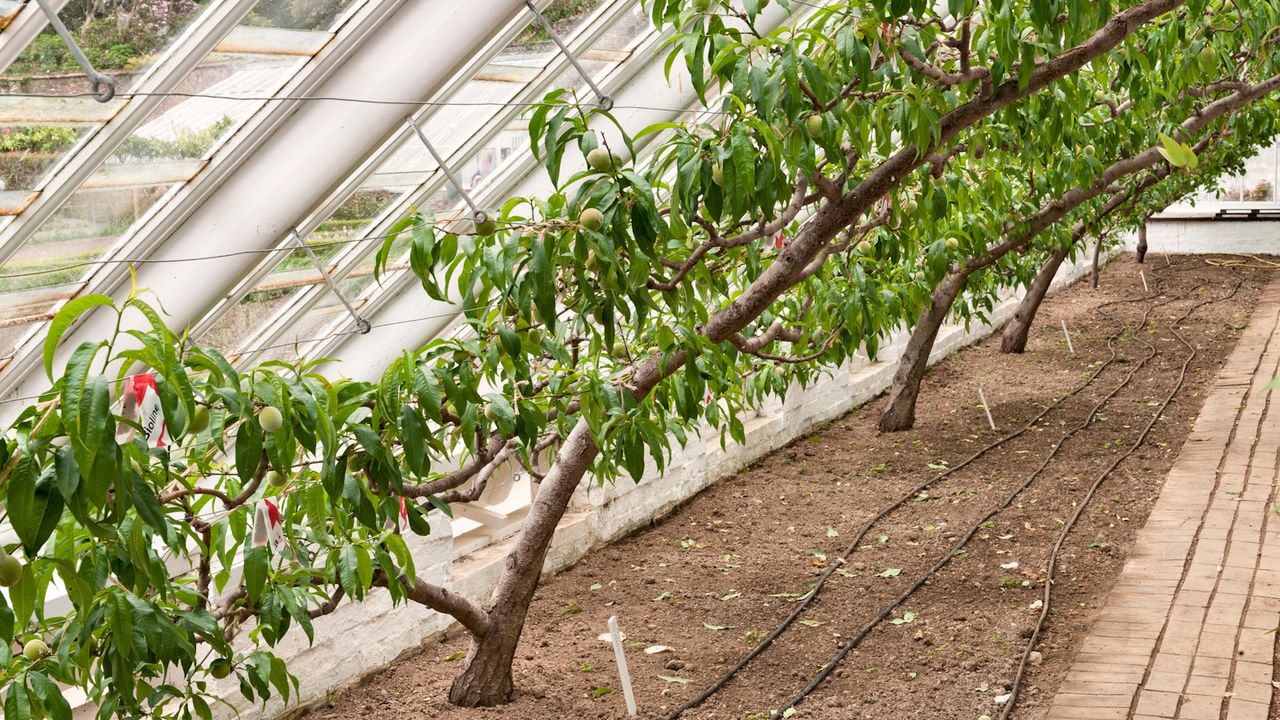Top Stories
Revolutionary Victorian Technique Boosts Peach Harvests Now!

BREAKING NEWS: A Victorian gardening technique is transforming peach cultivation in cold, wet climates, allowing fruit enthusiasts to achieve bumper harvests where once it seemed impossible. Gravetye Manor in Sussex, England, has become a beacon of hope for gardeners, showcasing how a historic glasshouse can ensure thriving peach trees.
This groundbreaking method, rooted in history since 1884, is currently generating buzz among horticulturists and gardening aficionados. During a recent visit, Head Gardener Tom Coward revealed how the glasshouse prevents severe issues like peach leaf curl, frost damage, and pest problems, allowing for high-quality fruit production year after year.
Peach leaf curl, a fungal disease that can devastate trees, thrives in excessively wet conditions, a common challenge in regions where peach trees are typically grown. By utilizing a Victorian glasshouse, Gravetye Manor effectively shields peach trees from these threats. Coward states, “By putting them under glass, you don’t get peach leaf curl. You get high-quality fruit early in the season, and you can keep the squirrels away.”
The glasshouse not only protects against diseases but also prevents frost from damaging the blossoms, which is crucial for fruiting. “The blossom also never gets frosted,” Coward explains, emphasizing that this method yields peaches with superior flavor that can ripen perfectly on the tree.
This innovation is particularly relevant as colder regions, including parts of the United States, grapple with similar climate challenges. Peach trees are typically best suited to hardiness zones 6 to 8, but thanks to this technique, gardeners in harsher climates can now dream of homegrown peaches.
Gravetye Manor’s historic glasshouse was restored in 2012, ensuring that this Victorian tradition continues to flourish. The advancement of glasshouse technology during the Victorian era, including improved ventilation and heating, played a crucial role in the ability to grow delicate fruits like peaches.
For those looking to replicate this success, Coward offers practical tips: “If you have space for a sizeable greenhouse, you can use this trick in your backyard with compact peach trees.” He suggests opting for well-draining soil and considers training techniques like oblique cordon training or espalier for better ventilation.
With the season for harvesting peaches approaching, gardeners should be on the lookout for fruit that turns yellow, blushes, and gives slightly when pressed. This careful attention can lead to an earlier harvest, especially when using a greenhouse.
The impact of this Victorian technique is immense, allowing those in colder regions to experience the joy of growing their own peaches. As interest surges, more gardeners are likely to explore this historic method, making homegrown peaches a reality for many.
Stay tuned for further updates on this exciting development in horticulture and how it could reshape gardening practices worldwide.
-

 World1 week ago
World1 week agoMass Production of F-35 Fighter Jet Drives Down Costs
-

 World1 week ago
World1 week agoGlobal Air Forces Ranked by Annual Defense Budgets in 2025
-

 Top Stories1 week ago
Top Stories1 week agoDirecTV to Launch AI-Driven Ads with User Likenesses in 2026
-

 World1 week ago
World1 week agoElectrification Challenges Demand Advanced Multiphysics Modeling
-

 Science1 week ago
Science1 week agoTime Crystals Revolutionize Quantum Computing Potential
-

 Top Stories1 week ago
Top Stories1 week agoNew ‘Star Trek: Voyager’ Game Demo Released, Players Test Limits
-

 Entertainment1 week ago
Entertainment1 week agoFreeport Art Gallery Transforms Waste into Creative Masterpieces
-

 Lifestyle1 week ago
Lifestyle1 week agoDiscover Reese Witherspoon’s Chic Dining Room Style for Under $25
-

 Lifestyle1 week ago
Lifestyle1 week agoLia Thomas Honored with ‘Voice of Inspiration’ Award at Dodgers Event
-

 Health1 week ago
Health1 week agoGavin Newsom Critiques Trump’s Health and National Guard Plans
-

 Entertainment1 week ago
Entertainment1 week agoFast & Furious Coaster Hits the Track at Universal Studios
-

 Science1 week ago
Science1 week agoWaning Crescent Moon: What to Expect on October 17









